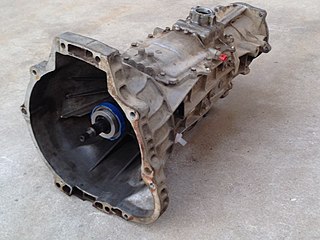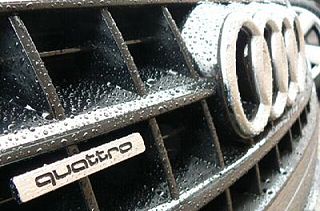
A clutch is a mechanical device that allows the output shaft to be disconnected from the rotating input shaft. The clutch's input shaft is typically attached to a motor, while the clutch's output shaft is connected to the mechanism that does the work.

An automatic transmission is a multi-speed transmission used in motor vehicles that does not require any input from the driver to change forward gears under normal driving conditions. Vehicles with internal combustion engines, unlike electric vehicles, require the engine to operate in a narrow range of rates of rotation, requiring a gearbox, operated manually or automatically, to drive the wheels over a wide range of speeds.
A traction control system (TCS), is typically a secondary function of the electronic stability control (ESC) on production motor vehicles, designed to prevent loss of traction of the driven road wheels. TCS is activated when throttle input and engine power and torque transfer are mismatched to the road surface conditions.

Four-wheel drive, also called 4×4 or 4WD, refers to a two-axled vehicle drivetrain capable of providing torque to all of its wheels simultaneously. It may be full-time or on-demand, and is typically linked via a transfer case providing an additional output drive shaft and, in many instances, additional gear ranges.

A continuously variable transmission (CVT) is an automated transmission that can change through a continuous range of gear ratios. This contrasts with other transmissions that provide a limited number of gear ratios in fixed steps. The flexibility of a CVT with suitable control may allow the engine to operate at a constant angular velocity while the vehicle moves at varying speeds.

A manual transmission (MT), also known as manual gearbox, standard transmission, or stick shift, is a multi-speed motor vehicle transmission system, where gear changes require the driver to manually select the gears by operating a gear stick and clutch.

In mechanical or automotive engineering, a freewheel or overrunning clutch is a device in a transmission that disengages the driveshaft from the driven shaft when the driven shaft rotates faster than the driveshaft. An overdrive is sometimes mistakenly called a freewheel, but is otherwise unrelated.

A limited-slip differential (LSD) is a type of differential gear train that allows its two output shafts to rotate at different speeds but limits the maximum difference between the two shafts. Limited-slip differentials are often known by the generic trademark Positraction, a brand name owned by General Motors and originally used for its Chevrolet branded vehicles.

Quattro is the trademark used by the automotive brand Audi to indicate that all-wheel drive (AWD) technologies or systems are used on specific models of its automobiles.

Engine braking occurs when the retarding forces within an internal combustion engine are used to slow down a motor vehicle, as opposed to using additional external braking mechanisms such as friction brakes or magnetic brakes.

A drive shaft, driveshaft, driving shaft, tailshaft, propeller shaft, or Cardan shaft is a component for transmitting mechanical power, torque, and rotation, usually used to connect other components of a drivetrain that cannot be connected directly because of distance or the need to allow for relative movement between them.

A sprag clutch is a one-way freewheel clutch. It resembles a roller bearing but, instead of cylindrical rollers, non-revolving asymmetric figure-eight shaped sprags, or other elements allowing single direction rotation, are used. When the unit rotates in one direction the rollers slip or free-wheel, but when a torque is applied in the opposite direction, the sprags tilt slightly, producing a wedging action and binding because of friction.
ATTESA is a four-wheel drive system used in some automobiles produced by the Japanese automaker Nissan, including some models under its luxury marque Infiniti.

The Honda RVF750R RC45 was a fully faired racing motorcycle created for homologation purposes for the Superbike World Championship by Honda Racing Corporation. The RVF750R was the successor to the VFR750R RC30. Like its predecessor, the RVF750R featured a DOHC liquid-cooled V4 4-stroke engine with gear driven cams and a single-sided swingarm, but unlike the RC30 it utilized electronic fuel injection, in a setup very similar to the production 1992 NR750. The US spec engine had a 749.2cc capacity and was rated at 101 horsepower; the European version was rated at 118 horsepower. A simple rewire modification to the PGM-FI box increased power in the US engine up to the 118 hp. It was manufactured from 1994 until 1995 and sold in limited numbers, followed by the VTR1000R SP-1 RC51 in 2000. Unlike the VFR750R RC30 and VFR750F from which the engine was originally derived the gear drive for the cams was moved from the centre of the engine in between the cylinders to the one side allowing a slightly narrower engine.
Clutch control refers to the act of controlling the speed of a vehicle with a manual transmission by partially engaging the clutch plate, using the clutch pedal instead of the accelerator pedal. The purpose of a clutch is in part to allow such control; in particular, a clutch provides transfer of torque between shafts spinning at different speeds. In the extreme, clutch control is used in performance driving, such as starting from a dead stop with the engine producing maximum torque at high RPM.
ControlTrac four-wheel drive is the brand name of a selectable automatic full-time four-wheel drive system offered by Ford Motor Company. The four-wheel drive system was designed and developed at BorgWarner under its TorqTransfer Systems division in the mid 1980s. BorgWarner calls the system Torque-On-Demand (TOD). ControlTrac was the first automatic system to use software control and no planetary or bevel geared center differential. Instead of a planetary or bevel geared center differential, the system uses a variable intelligent locking center multi-disc differential.

The Honda VFR1200F is the 7th generation Honda sport touring motorcycle from the VF and VFR line motorcycles powered by a transverse mounted V4 engine. The VFR1200F has several new technologies including the first dual clutch transmission offered on a motorcycle.

A motorcycle transmission is a transmission created specifically for motorcycle applications. They may also be found in use on other light vehicles such as motor tricycles and quadbikes, go-karts, offroad buggies, auto rickshaws, mowers, and other utility vehicles, microcars, and even some superlight racing cars.
Electromagnetic clutches and brakes operate electrically, but transmit torque mechanically. This is why they used to be referred to as electro-mechanical clutches or brakes. Over the years, EM became known as electromagnetic versus electro mechanical, referring more about their actuation method versus physical operation. Since the clutches started becoming popular over 60 years ago, the variety of applications and brake and clutch designs has increased dramatically, but the basic operation remains the same.

Car controls are the components in automobiles and other powered road vehicles, such as trucks and buses, used for driving and parking.














